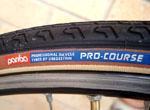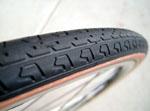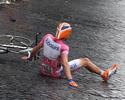
Recently on Cyclingnews.com |
Reviews
Pariba Pro-Course: Par for the course
By Anthony Tan
 |
Most roadies tend to be fairly loyal to one brand of tyre or another, almost for the life of their cycling career. Which is great for the well-known brands, but what about the not so well known?
Pariba are a relative newcomer to the scene, but is a subsidiary of Dutch rubber giant (not giant rubber) Vredestein, the largest bicycle tyre manufacturer in Europe. The connection with Pariba is not well publicised, as the brands cater for different markets: Vredestein tend to address the needs of the masses, whereas Pariba focuses most of their attention on the high-performance devotees.
The Pro-Course sits in the middle of Pariba's range of racing tyres - although 'middle-of-the-range' is a term that should be used sparingly.
Along with the rest of the Pariba range, the Pro-Course is manufactured by hand using a sock-like casing. The polyamide fibres in the casing are laid parallel to each other and are then impregnated with rubber; this differs from the majority of clincher manufacturers where the cloth fabric is arranged in layers (or 'plies'), where each layer runs perpendicular to the next layer.
The techies at Pariba assert that a polyamide weave may seem stronger but over time, threads can rub against each other, weakening them. Furthermore, they claim that overlapping plies generate friction and can affect the rolling resistance of a tyre.
And going against the grain of what's in vogue, the Pro-Course uses the same rubber compound across the entire tread area and a semi-slick tread pattern. These days the norm appears to be the dual compound, dual-colour combination, which Michelin and Vittoria have actively promoted on their high-end hoops.
An apt word to describe the road feel of the Pro-Course is comfy. I tend to pump up my tyres fairly hard, around 115 psi to ensure the least possible rolling resistance, and my first thoughts were that I hadn't pumped up them up enough. But then it clicked: the Pro-Course is a racing tyre, so the softer compound lends itself to that luxurious cushy feeling as well as providing plenty of traction.
And while we're on the subject of traction, I've taken the Pro-Course just about as hard as I'd like to round zee bends and never felt like I was about to have an unexpected relationship with the tarmac. Having said that, it's always hard to find the real limit without substantial loss of skin.
But that's when Tech Editor John Stevenson informed me about bicycle wheel guru Jobst Brandt. To test a bicycle tyre's stickiness, Brandt often dressed up in a motorbike outfit and used to go around corners at ridiculous speeds - in torrential rain. Sorry John, I'm not prepared to go that far.
 |
A small niggle is the use of the semi-slick tread pattern. The bottom line is that any tread pattern on a bicycle tyre is essentially useless (excluding the placebo effect). In wet weather, car tyres require a grooved tread due to the 'square' nature of the tyre's contact with the road; the fact that bicycle tyres have a curved road contact means that when it's bucketing down, the benefits of a tread pattern are negated.
However purely cosmetic attributes are why many of us buy nice, purdy stuff in the first place - so why not enjoy the ride on a high performance, good-lookin' set of racing hoops?
Weight: 240 grams (700 x 23c)
Max Pressure: 8 bar (115 psi)
Price guide: $39.99 (USA), £27.95 (UK)
Pro: Excellent road feel, quality casing
Con: Nothing mind-blowingly innovative or special
More information: Vredestein
USA website, Vredestein
website (in Dutch only)
Cyclingnews Rating: ![]()
What do you think of the Pariba Pro-Course? Let us know
Recent techTour tech: Zipp's slippery
new wheel revealed |

